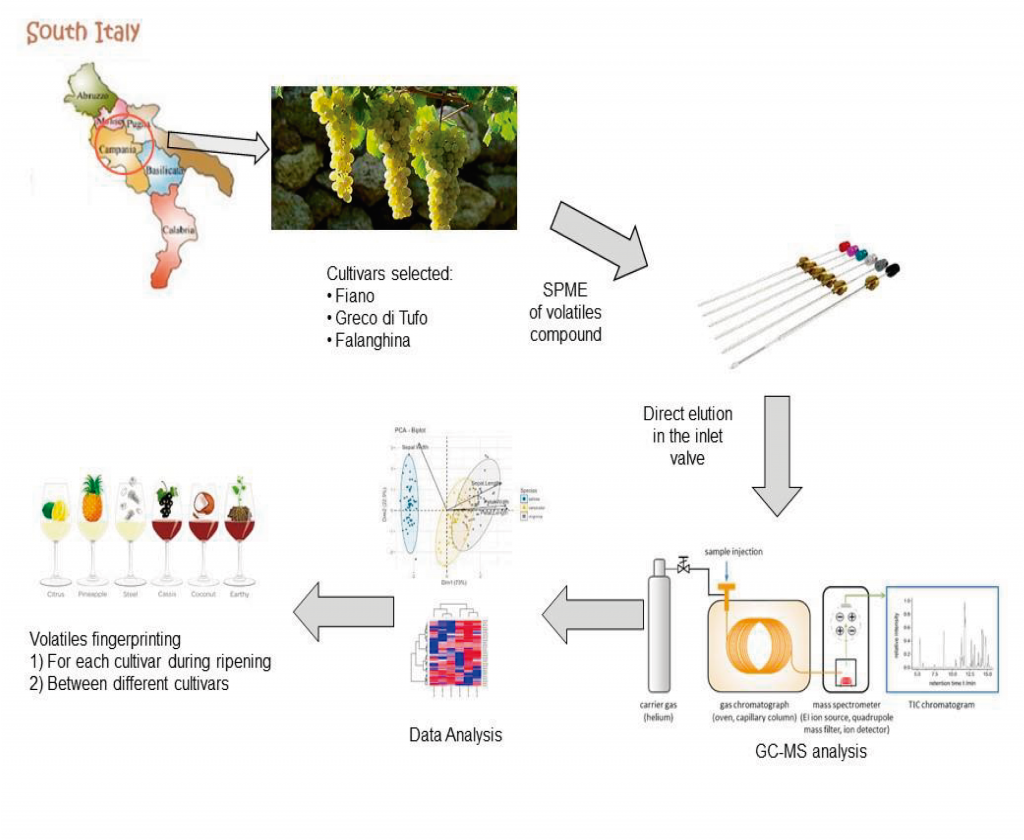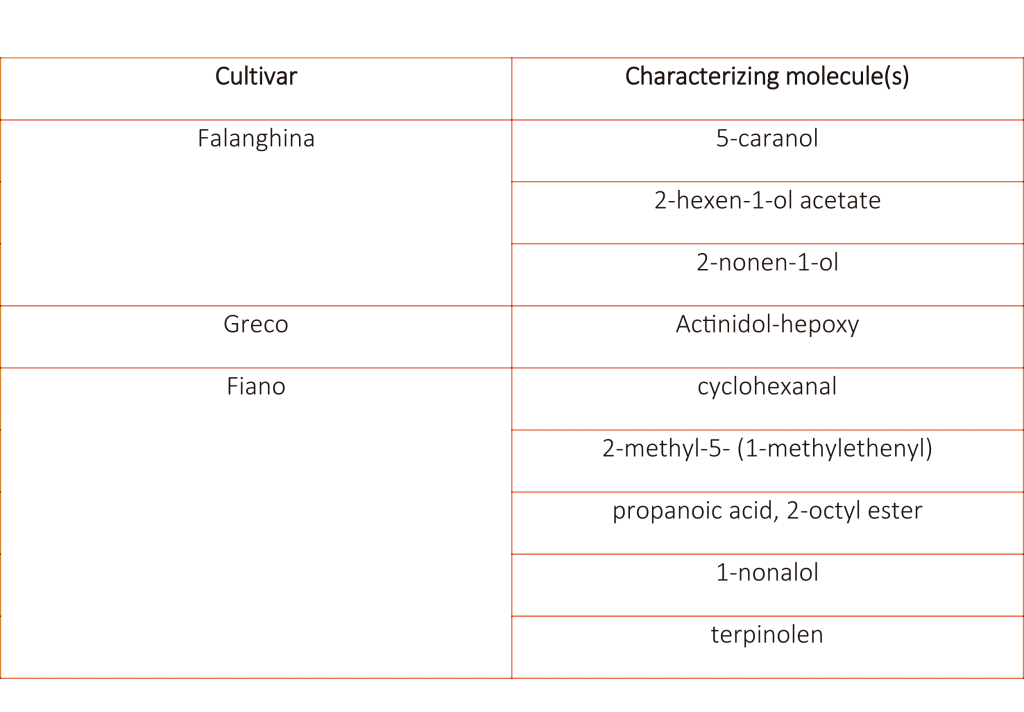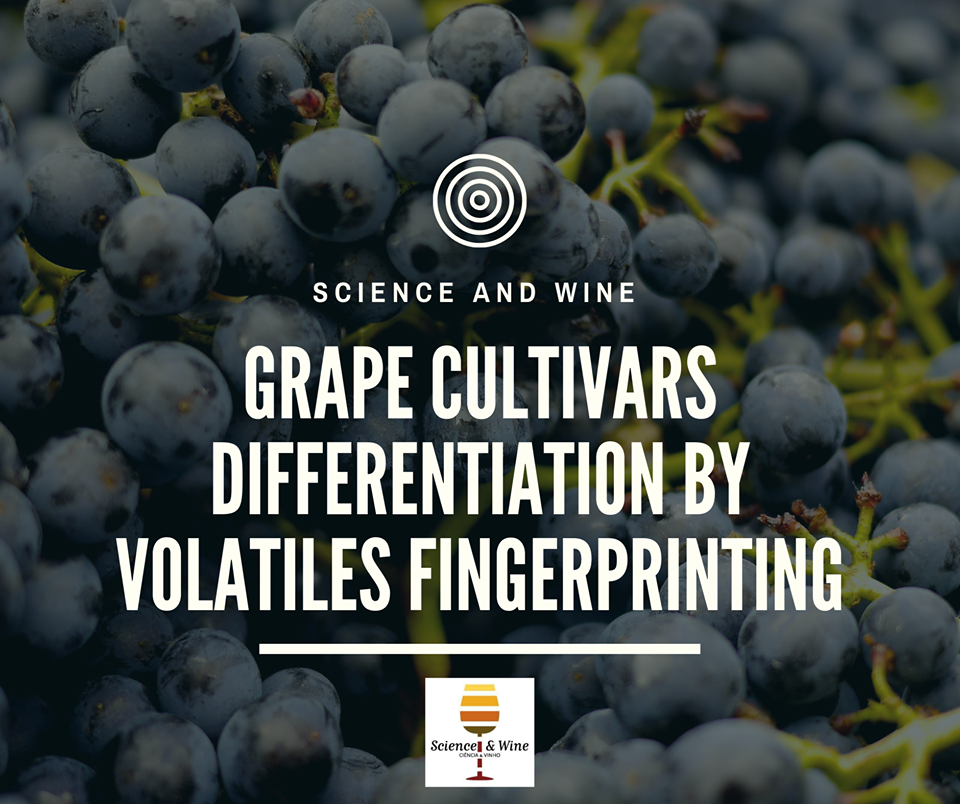By Andrea Carpentieri, Angelo Sebastianelli , Chiara Melchiorre , Gabriella Pinto, Marco Trifuoggi, Vincenzo Lettera and Angela Amoresano
The biomolecular characterization of foods and beverages represent nowadays an intriguing task for the scientific community. While nonvolatile compounds of a wine, e.g. polysaccharides, organic acids, mineral salts and polyphenols, have a great impact on the mouthfeel with acidity and salinity perceptions and astringency, the volatile component is the main responsible of wine aroma that contributes to the peculiar recognizability of a vine. Food aroma is the result of the complex interaction of small volatile molecules and odor receptors [1] and, although its perception might be affected by subjectivity, it is considered as the first step in quality assessment. A common practice for the recognition of wines is in fact based on the flavors recognition: this peculiar capacity of tasters needs to be properly trained and developed. The characteristic smell of wines aroma come from grapes; pedoclimatic conditions and viticultural practices can enormously influence the varietal flavorings [2, 3]. Volatile molecules are secondary metabolites of the plant, i.e. they do not participate in the metabolic processes essential for the life of the plant itself but they have a crucial role in the defense mechanisms of the plant against the adversities characterizing the environment in which they live [4, 5]. The ecological function of secondary metabolism is expressed in the defense role that these substances have with regard to the biotic environment due to their irritating, toxic and repellent properties. During the evolution, plants have developed systems and strategies for growth and survival [6, 7]. The stimulation of secondary metabolism takes place at the expense of the growth of the plant, as it hampers part of the nourishment towards defense substances. Secondary metabolites can therefore be considered as available molecules for growth and development, but are indispensable for the survival of the species.
On a total 800 volatile compounds identified in wines (terpenoids, phenols, alcohols, esters, aldehydes, ketones, lactones) only few of them contribute to the wine bouquet [8-11]. The olfactory impact, considered as the threshold of perception of each individual compound, is dependent on chemical nature of molecule as well as its concentration [11]. In fact, some compounds present in trace amounts may have a greater impact than other aromatic compounds present in higher concentrations [11].
The study of the volatile compounds in grapes has been scarcely examined unlike that of wine [12, 13] but it is equally important for the characterization of a specific cultivar [13, 14]. The main reason for this lack of informations, relies in the fact that within the berries, the majority of volatile molecules are still in their glycosylated form[15-19]. During fermentation oligosaccharides are hydrolyzed thus releasing the free volatile molecules.
Recently, by using mass spectrometry techniques we outlined the proteomic profile [20] of three different cultivars of Vitis vinifera peculiar of south Italy (Campania) used for white wine production (Fiano, Greco and Falanghina) showing significant changes in protein expression along the ripening process. On the same set of samples, the molecular profiling of the volatile fraction was outlined by Solid Phase Micro Extraction hyphenated with Gas Chromatography-Mass Spectrometry (SPME/GC-MS). In a single experiment, more than 60 heterogeneous analytes were captured by SPME and then unambiguously identified by GC-MS. The analytical workflow adopted in this study (Fig.1) can be extended to the typization of different foods and beverages thanks to its high sensitivity, reproducibility and accuracy.
The relative quantification (based on chromatographic peak areas) of identified analytes, showed the trend for each molecule during maturation process for each cultivar. PCA, performed on the peak area of the volatile compounds identified by GC-MS for each sampling date of the three different cultivars, show a peculiarity of the biomolecular pattern of Fiano and a good overlap between Greco and Falanghina.

Analytes were divided into five categories and then we plotted the average area of each class of compounds to monitor their trends. Among identified compounds, we focused on some of the aromatic descriptors, which resulted to be present in the three samplings of each cultivar (Tab. 1). These results were then compared with data from the other cultivars. For Falanghina, during the maturation process, we observed a general decrease of aldehydes, alcohols (except for hexanal, 2-hexen-1-ol e 1-hexanol), terpenes (except for eucalyptol) and esters; the same behavior cannot be observed for norisoprenoids. The same trend for the majority of compounds was observed in Greco; butanol, 3-methyl, pentanal, hexanal, 5-hepten-2-one, 6methyl represent an exception in the general behavior. As for Fiano, the general trend of molecules is not linear as the ones described before. For this cultivar, we could observe a reduction in esters amount.
While the majority of volatile compounds are glycosylated within grapes [18, 19], molecules identified in this paper represent the non-glycosylated (therefore more volatile) fraction. Glycosylated volatiles pass from the grape to the wine where they undergo chemical and enzymatic hydrolysis, which liberates terpenes and norisoprenoids from the sugar making them volatile [21]. This process explains why the volatile component of the grapes is composed of only few molecules, compared to the complexity of the compounds identified in wine, where not only the varietal component but also the esters and alcohols produced by the yeast are found.
The development of fast and simple analytical approaches and their application on real samples has a key role in food quality assessment and product typization. The increasing demand of products in the food market led the producers to introduce new and intensive farming techniques that, in turn, introduced a higher level of complexity among existing cultivars.
As a whole, our data suggest that the typization of edible products on a molecular level is nowadays possible and of fundamental importance not only for the safeguard of DOP/IGP products but also for preserving local economies.
Read more about this study in: DOI: 10.1016/j.heliyon.2019.e02287


Dr. Andrea Carpentieri graduated at the University of Naples Federico II in 2002 in Biochemistry.
2004-2007 – PhD in chemical sciences (XX cycle) at the Department of Organic Chemistry and Biochemistry, University of Naples “Federico II”, tutor Prof. P. Pucci.
2008-2010 Research Associated, Boston University School of Medicine tutors: Prof. J. Samuelson, Prof. P. Robbins and Prof. C.E. Costello.
2011- Fellow at the Department of Organic Chemistry and Biochemistry, University of Naples “Federico II”, tutors Prof. P.Pucci and Prof. A. Amoresano).
2011-Visiting Researcher, Boston University School of Medicine tutors: Prof. J. Samuelson, Prof. P. Robbins and Prof.C.E. Costello.
20/12/2011-present Assistant Professor, Department of Chemical Sciences, University of Naples “Federico II”.
His research activity is devoted to the analysis of biomolecules and their interactions in complex biological matrices. These studies are carried out by integrating classical biochemical procedures, with advanced bio molecular mass spectrometric procedures. Reviewer of many scientific journals and PhD theses. The research activity is documented by the publication of over 45 articles in international peer review journals dealing with different aspects of analytical biochemistry.
Scopus Author ID: 57202563415
acarpent@unina.it
References:
- Genovese, A., et al., Sensory properties and aroma compounds of sweet Fiano wine. Food Chemistry, 2007. 103(4): p. 1228-1236.
- Styger, G., B. Prior, and F.F. Bauer, Wine flavor and aroma. Journal of industrial microbiology & biotechnology, 2011. 38(9): p. 1145.
- Molina, A.M., et al., Influence of wine fermentation temperature on the synthesis of yeast-derived volatile aroma compounds. Applied Microbiology and Biotechnology, 2007. 77(3): p. 675-687.
- Dunlevy, J., et al., The production of flavour & aroma compounds in grape berries, in Grapevine molecular physiology & biotechnology. 2009, Springer. p. 293-340.
- Ali, K., et al., Metabolic constituents of grapevine and grape-derived products. Phytochemistry Reviews, 2010. 9(3): p. 357-378.
- Qiu, W., A. Feechan, and I. Dry, Current understanding of grapevine defense mechanisms against the biotrophic fungus (Erysiphe necator), the causal agent of powdery mildew disease. Horticulture research, 2015. 2: p. 15020.
- Bennett, R.N. and R.M. Wallsgrove, Secondary metabolites in plant defence mechanisms. New phytologist, 1994. 127(4): p. 617-633.
- Sánchez-Palomo, E., M.C. Diaz-Maroto, and M.S. Perez-Coello, Rapid determination of volatile compounds in grapes by HS-SPME coupled with GC–MS. Talanta, 2005. 66(5): p. 1152-1157.
- Sagratini, G., et al., Comparative study of aroma profile and phenolic content of Montepulciano monovarietal red wines from the Marches and Abruzzo regions of Italy using HS-SPME–GC–MS and HPLC–MS. Food Chemistry, 2012. 132(3): p. 1592-1599.
- Bosch-Fusté, J., et al., Volatile profiles of sparkling wines obtained by three extraction methods and gas chromatography–mass spectrometry (GC–MS) analysis. Food Chemistry, 2007. 105(1): p. 428-435.
- Francis, I. and J. Newton, Determining wine aroma from compositional data. Australian Journal of Grape and Wine Research, 2005. 11(2): p. 114-126.
- Razungles, A., et al., Quantitative studies on terpenes, norisoprenoides and their precursors in several varieties of grapes [carotenoids]. Sciences des Aliments, 1993.
- Gürbüz, O., J.M. Rouseff, and R.L. Rouseff, Comparison of aroma volatiles in commercial Merlot and Cabernet Sauvignon wines using gas chromatography− olfactometry and gas chromatography− mass spectrometry. Journal of Agricultural and Food Chemistry, 2006. 54(11): p. 3990-3996.
- Pozo-Bayón, M., et al., Polydimethylsiloxane solid-phase microextraction–gas chromatography method for the analysis of volatile compounds in wines: Its application to the characterization of varietal wines. Journal of Chromatography A, 2001. 922(1-2): p. 267-275.
- Palomo, E.S., et al., Contribution of free and glycosidically-bound volatile compounds to the aroma of muscat “a petit grains” wines and effect of skin contact. Food Chemistry, 2006. 95(2): p. 279-289.
- Selli, S., et al., Aroma components of cv. Muscat of Bornova wines and influence of skin contact treatment. Food Chemistry, 2006. 94(3): p. 319-326.
- Dimitriadis, E. and P. Williams, The development and use of a rapid analytical technique for estimation of free and potentially volatile monoterpene flavorants of grapes. American Journal of Enology and Viticulture, 1984. 35(2): p. 66-71.
- Gunata, Y., et al., The aroma of grapes I. Extraction and determination of free and glycosidically bound fractions of some grape aroma components. Journal of Chromatography A, 1985. 331: p. 83-90.
- Nasi, A., et al., Identification of free and bound volatile compounds as typicalness and authenticity markers of non-aromatic grapes and wines through a combined use of mass spectrometric techniques. Food Chemistry, 2008. 110(3): p. 762-768.
- Carpentieri, A., et al., Mass spectrometry based proteomics for the molecular fingerprinting of Fiano, Greco and Falanghina cultivars. Food Research International, 2019. 120: p. 26-32.
- Mateo, J. and M. Jiménez, Monoterpenes in grape juice and wines. Journal of Chromatography A, 2000. 881(1-2): p. 557-567.

